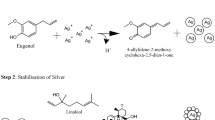Abstract
This study aimed to develop a photostable ointment containing 0.13% of silver chloride and evaluate the antimicrobial activity of the product. The ointment formulation was prepared by the reaction between silver nitrate and sodium chloride in a mixture of polyethylene glycol 600 and polyethylene glycol 4000 in a ratio of 5:2 (w/w). When in contact with water, silver chloride nanocubes precipitated out of the formulation. These particles had an average diameter of about 180 nm and a zeta potential of about − 41 mV. Their optical properties and crystalline nature were confirmed by UV–Vis spectroscopy and XRD analysis, respectively. The product could maintain the liberation of silver within 3 days and up to 7 days with 0.267 mg silver released in total. Moreover, the product had shown broad-spectrum antibiotic activities against both Gram-positive and Gram-negative strains. The antibacterial effects of 0.13% silver chloride ointment were better than those of the 1% silver sulfadiazine cream at all tested organisms. These superior results suggest that this ointment formulation may be an effective therapeutic agent for preventing wound infection.





Similar content being viewed by others

Availability of Data and Material
Not applicable.
Code Availability
Not applicable.
References
Atiyeh, B. S., Costagliola, M., Hayek, S. N., et al. (2007). Effect of silver on burn wound infection control and healing: Review of the literature. Burns: Journal of International Society for Burn Injuries, 33(2), 139–148. https://doi.org/10.1016/j.burns.2006.06.010
Modak, S. M., & Fox, C. L., Jr. (1973). Binding of silver sulfadiazine to the cellular components of Pseudomonas aeruginosa. Biochemical Pharmacology, 22(19), 2391–2404. https://doi.org/10.1016/0006-2952(73)90341-9
Wright, J. B., Lam, K., & Burrell, R. E. (1998). Efficacy of topical silver against fungal burn wound pathogens. American Journal of Infection Control, 27(4), 344–350. https://doi.org/10.1016/S0196-6553(99)70055-6
Nowack, B., Krug, H. F., & Height, M. (2011). 120 years of nanosilver history: Implications for policy makers. Environmental Science and Technology, 45(4), 1177–1183.
Trinh, N. D., Nguyen, T. T. B., & Nguyen, T. H. (2015). Preparation and characterization of silver chloride nanoparticles as an antibacterial agent. Advances in Natural Sciences: Nanoscience and Nanotechnology, 6, 45011–45016.
Rai, M., Yadav, A., & Gade, A. (2009). Silver nanoparticles as a new generation of antimicrobials. Biotechnology Advances, 27, 76–83. https://doi.org/10.1016/j.biotechadv.2008.09.002
Pal, S., Tak, Y. K., & Song, J. M. (2007). Does the antibacterial activity of silver nanoparticles depend on the shape of the nanoparticle? A study of the gram-negative bacterium Escherichia coli. Applied and Environment Microbiology, 27(6), 1712–1720. https://doi.org/10.1128/AEM.02218-06
Raval, N., Maheshwari, R., Kalyane, D., et al. (2019). Importance of physicochemical characterization of nanoparticles in pharmaceutical product development. Basic Fundamentals of Drug Delivery (pp. 369–400). Academic Press.
Harsányi, E. G., Tóth, K., Pungor, E., et al. (1984). Study of the potential response of solid-state chloride electrodes at low concentration ranges. Talanta, 31(8), 579–584. https://doi.org/10.1016/0039-9140(84)80173-3
Kim, S. W., Chung, H., Kwon, J. H., Yoon, H. G., & Kim, W. (2010). Facile synthesis of silver chloride nanocubes and their derivatives. Bulletin of the Korean Chemical Society, 31(10), 2918–2922. https://doi.org/10.5012/bkcs.2010.31.10.2918
Baghkheirati, E. K., Bagherieh-Najjar, M. B., Fadafan, H. K., & Abdolzadeh, A. (2015). Synthesis and antibacterial activity of stable bio-conjugated nanoparticles mediated by walnut (Juglans regia) green husk extract. Journal of Experimental Nanoscience, 11, 512–517. https://doi.org/10.1080/17458080.2015.1090020
Dakal, T. C., Kumar, A., Majumdar, R. S., & Yadav, V. (2016). Mechanistic basis of antimicrobial actions of silver nanoparticles. Frontiers in Microbiology, 7(1831), 1–17. https://doi.org/10.3389/fmicb.2016.01831
Souza, A., Mehta, D., & Leavitt, R. W. (2006). Bactericidal activity of combinations of Silver-Water DispersionTM with 19 antibiotics against seven microbial strains. Current Science, 91(7), 926–929.
Morones, J. R., Elechiguerra, J. L., Camacho, A., et al. (2005). The bactericidal effect of silver nanoparticles. Nanotechnology, 16, 2346–2353. https://doi.org/10.1088/0957-4484/16/10/059
Ishida, T. (2018). Antibacterial mechanism of Ag+ ions for bacteriolyses of bacterial cell walls via peptidoglycan autolysins, and DNA damages. MOJ Toxicology, 4(5), 345–350. https://doi.org/10.15406/mojt.2018.04.00125
Author information
Authors and Affiliations
Contributions
T. H. Nguyen and T. T. B. Nguyen conceived of the presented idea; T. T. B. Nguyen and X. T. Nguyen planned and carried out the experiments; X. T. Nguyen wrote the manuscript in consultation with T. T. B. Nguyen; T. H. Nguyen supervised the project.
Corresponding author
Ethics declarations
Research Involving Humans and Animals Statement
None.
Conflict of Interest
None.
Funding Statement
This study was not supported by any grant.
Informed Consent
None.
Additional information
Publisher's Note
Springer Nature remains neutral with regard to jurisdictional claims in published maps and institutional affiliations.
Rights and permissions
About this article
Cite this article
Nguyen, T.T.B., Nguyen, T.H. & Nguyen, X.T. Preparation and Antibacterial Evaluation of Polyethylene Glycol Ointment Containing In Situ Silver Chloride Nanoparticles. BioNanoSci. 12, 203–209 (2022). https://doi.org/10.1007/s12668-021-00935-1
Accepted:
Published:
Issue Date:
DOI: https://doi.org/10.1007/s12668-021-00935-1



